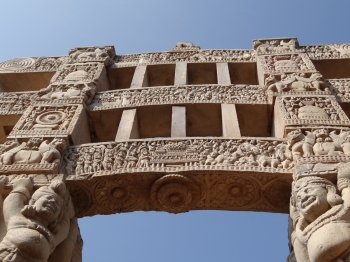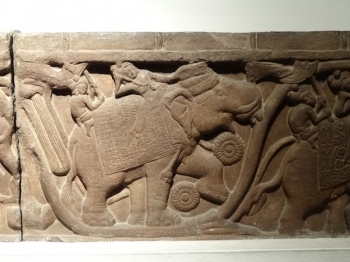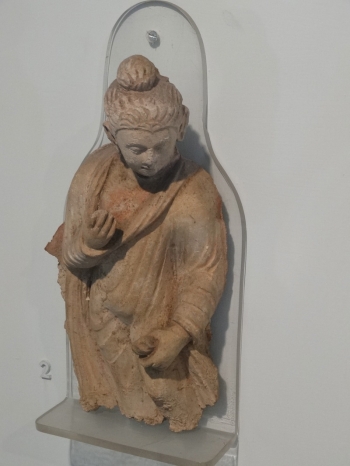One of the curiosities of history is the lack of evidence of any image of the Buddha for approximately 400 years after his death. The early academic consensus favored a period of defacto aniconism, a nearly half millennial span during which, Albert Foucher explained in 1917, “the idea [of an anthropomorphic Buddha] had not even presented itself to the Indian mind.”
The prevailing wisdom of six decades was upended in 1985 when American Buddhist art historian John C Huntington made the rather startling claim that Buddha images had been manufactured as early as shortly after the Buddha’s death. His strongest piece of evidence was a Chinese ceramic pot adorned with a Buddha image dated to the middle of the first century BCE. Unfortunately, this turned out to be a forgery and not much more was heard about his theories until his wife, Susan Huntington, returned to the topic in 1990 in Early Buddhist Art and the Theory of Aniconism.
She argued that scholars who defined early Buddhist art as aniconic revealed themselves as misdirected by preconception, unable to see what the art offered because they were too busy looking for what they expected, for what wasn’t there. Scholars wanted to see an anthropomorphic Buddha and were puzzled when they didn’t. As a result, too much time was spent discussing what isn’t, instead of what is.
When Huntington looked, she didn’t see artists trying to find a way to depict scenes of the life of the Buddha sans Buddha. What she saw instead were depictions of events contemporaneous to the artists' own lives.
“It is possible that most, if not all, of these compositions do not represent events in the life of the Buddha at all, but rather portray worship and adoration at sacred Buddhist sites.” The artists, in other words, were sculpting scenes of Buddhist festivals. There was nothing aniconic about the art at all, and she closed by suggesting her observations might require a “revision of virtually all … areas of study” related to early Buddhist art.
As one scholar at Colombia University was quick to point out, all Huntington had succeeded in doing was displacing the question. In her 1991 article, Aniconism and the Multivalence of Emblems, Vidya Dehejia asked, “what could possibly have led the artist to avoid portraying…the human actor who played the part of the Buddha?”
Or, as another American art scholar, Rob Linrothe (1993), asked in summarizing Huntington’s and Dehejia’s debate, “Why is it, if there was no disinclination to represent the Buddha, that no one plays the part of the Buddha himself?” Dehejia also found the idea somewhat insulting to the builders of the great stupas, that they should decorate their monuments with “merely pictures of a pageant!” There is besides, she notes, no evidence that Buddhists ever staged such festivals.
Despite presenting a less than compelling case, the Huntingtons’ reevaluation of aniconism was helpful in reviving what had become a largely forgotten issue. As Linrothe notes, one of their accomplishments was calling attention to the lack of examples pointing to a textual tradition prohibiting the creation of anthropomorphic images. While Foucher and Coomaraswamy had recognized the absence of such, a number of examples had cropped up in the intervening years.
As John Huntington showed, though, these examples were overgeneralized, mistranslated or so decontextualized as to radically change their meaning, like that of a rule prohibiting monastery walls to be adorned with figures of men and women, which in context is a rule against ostentatious decoration, and nothing at all to do with anthropomorphic art.
Huntington makes the more important point that if the creation of Buddha images had been a serious issue, it would have been explicitly addressed in the vinaya, the rather copious compendium of rules under which monks and nuns go about their daily lives. Huntington notes that such a prohibition does in fact exist in the vinaya of one of the early schools of Buddhism, the Sarvastivadans, but to support his idea for Buddha image making in the pre-Common era had to dismiss the Sarvastivadan example as being an outlier and therefore not part of the mainstream tradition. (In fact, the real problem with this example is that the extant version of the text is a 5th century CE Chinese translation and therefore suspect as a document composed in the era under consideration).
Furthermore, the work of Gregory Schopen shed new light on early scholarly views of the Mahayana, one of the two major branches of Buddhism. The appearance of the first Buddha images at around the same time as the appearance of some of the more important early Mahayana texts seemed to many to have been no coincidence. It was widely held that Mahayana was a popular form of Buddhism directed by - or directed toward - the laity, who required simpler forms of practice, such as the worship of images.
Inscriptional evidence from some of the earliest Buddha images, though, has shown that it wasn’t the common merchant, artisan or peasant who paid for the erection or painting of Buddhas. Schopen (1989) writes in his summary of donative inscriptions:
Though images were introduced at different times at different sites they were almost always introduced by the same group: everywhere either monks or nuns. It would appear that the image and its attendant cult were a major preoccupation of nuns and monks; that they everywhere introduced the cult and everywhere disproportionately supported it.
What’s more, these monks and nuns were probably not Mahayanists.
While the monks promoting the cult in the 4th - 5th century at Ajanta, Sarnath, and Mathuri were predominately Mahayana monks, those involved in the same cult at Sravasti, Kausambi, Mathura, etc., in the Kusan period [1st century CE] almost certainly were not. The widespread assumption that connects the image cult with the Mahayana is simply not well-founded. (p. 166).
While it seems now that the Huntingtons made rather tenuous claims, their work is important for having reopened discussion on what was a largely forgotten topic in Buddhist history. They did not single-handedly reconceptualize Buddhist aniconism, but they certainly stimulated others who did. Over the next decade and a half, new perspectives emerged redefining the reading of aniconic symbols, and offering a more nuanced depiction of their evolution during the 400 year period in which no Buddha is to be found.
References
Dehejia, V. 1991 Aniconicm and the Multivalence of Emblems. Ars Orientalis. 21 (1) 45-66.
Foucher, A., Thomas, F. W., & Thomas, L. A. 1917. The beginnings of Buddhist art and other essays in Indian and Central-Asian archæology. Paris, P. Geuthner.
Huntington, JC. 1985 Origin of the Buddha Image: Early Image Traditions and the Concept of Buddhadarsnapunya. In Studies of Buddhist Art of South Asia. A.K. Narain. ed. New Delhi: Kanak. 23-58.
Huntington, S. 1990 Early Buddhist Art and the Theory of Aniconism. Art Journal. 39 (4) 401-408.
Linrothe, R. 1993 Inquiries into the Origin of the Buddha Image: A Review. East and West. 43 (1-4) 1-16. Schopen, G. 1989 On Monks, Nuns and 'Vulgar' Practices: The Introduction of the Image Cult into Indian. Artibus Asiae. 49 (1/2) 153-168.
Back to In My Image series homepage
Linrothe, R. 1993 Inquiries into the Origin of the Buddha Image: A Review. East and West. 43 (1-4) 1-16. Schopen, G. 1989 On Monks, Nuns and 'Vulgar' Practices: The Introduction of the Image Cult into Indian. Artibus Asiae. 49 (1/2) 153-168.
Back to In My Image series homepage

















